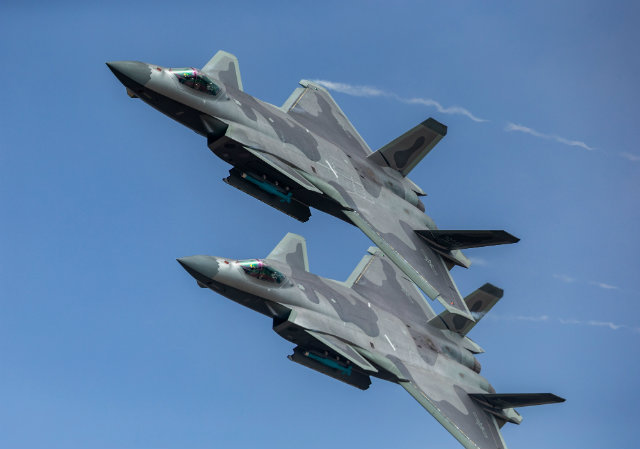A Chinese defence whitepaper has outlined Beijing’s commitment to building a stronger, more capable People’s Liberation Army Air Force (PLAAF), but is tantalizingly short on detail.
Entitled “China’s National Defense in the New Era,” the whitepaper lists several national defence aims, the foremost being deterring and resisting aggression, ensuring political and social security, and opposing the independence of Taiwan, which Beijing views as a breakaway province. Other objectives include safeguarding China’s interests overseas.

The J-20 was the only combat jet mentioned in the whitepaper
Rex
Beijing’s last major whitepaper on defence was published in 2015.
The paper summarizes PLAAF missions as aviation, airborne, surface-to-air missiles, radar, electronic countermeasures, and communications forces, which fall under five territorial commands and one airborne corps. A key focus of the PLAAF is transitioning from territorial defence to offensive and defensive operations, with a focus on strategic early warning, air strikes, air and missile defence, information countermeasures, as well as airborne operations.
“China’s armed forces conduct air defense, reconnaissance and early warning, monitor China’s territorial air and peripheral air space, carry out alert patrols and effectively respond to emergencies and threats to maintain order and security in the air,” says the whitepaper.
Specifics about individual systems are all but entirely absent. There is only one mention of an aircraft type, the Chengdu J-20, in a short passage about new equipment that has been “commissioned.”
The report makes no mention of other prominent Chinese aircraft programmes such as the AVIC FC-31, Xian Y-20 strategic transport, or the H-20 strategic bomber. Also not mentioned are China’s exports of defence equipment, such as UAVs, and the role this plays in the country’s defence strategy.
It adds that the PLAAF’s training is more realistic and based on operational plans. It has also conducted “combat patrols” in the South China Sea and “security patrols” in the East China Sea.
“Aiming at safeguarding national unity, China’s armed forces strengthen military preparedness with emphasis on the sea,” says the whitepaper. “By sailing ships and flying aircraft around Taiwan, the armed forces send a stern warning to the ‘Taiwan independence’ separatist forces.”
The stark warnings about Taiwan, which include a statement that Beijing is willing to use force to reunify it, come amid reports that Washington DC is poised to approve the sale of an undisclosed number of Lockheed Martin F-16Vs to Taipei. In early July, the US State Department cleared the sale of 108 M1A2T main battle tanks to Taiwan, drawing a sharp rebuke from Beijing.
Andrew Erickson is professor of strategy at the US Naval War College, and an observer of Chinese military affairs.
“Four years was a long time to wait for a document that generally restates what experts already know,” he says about the whitepaper. “It is vague in many areas, and unclear in its specifics: most statistics regarding exercises, for example, are hard to interpret absent additional context. Among its extremely limited content on hardware and force structure, it states that the J-20 fighter and DF-26 missile have been ‘commissioned.’”
Source: FlightGlobal.com


























